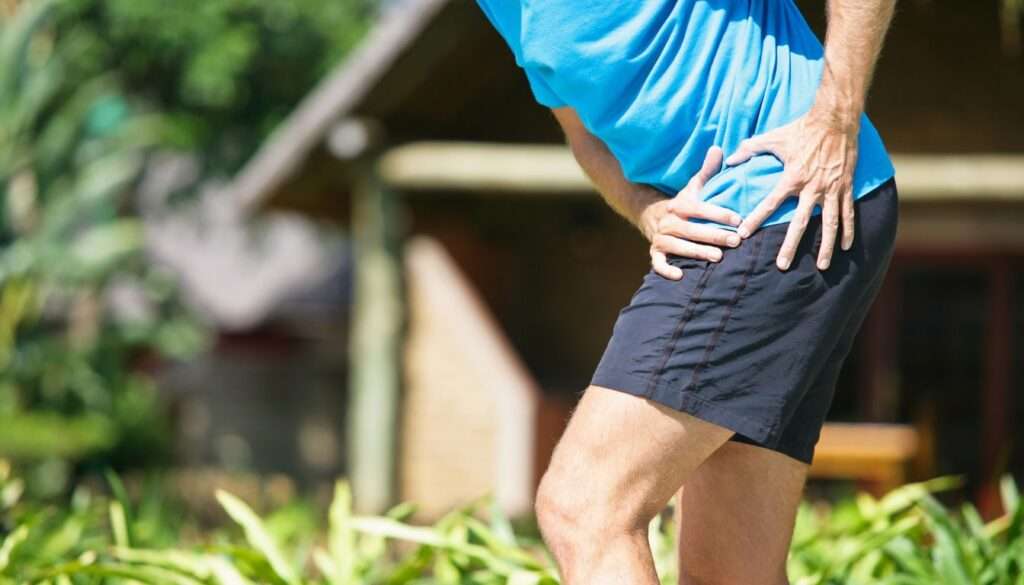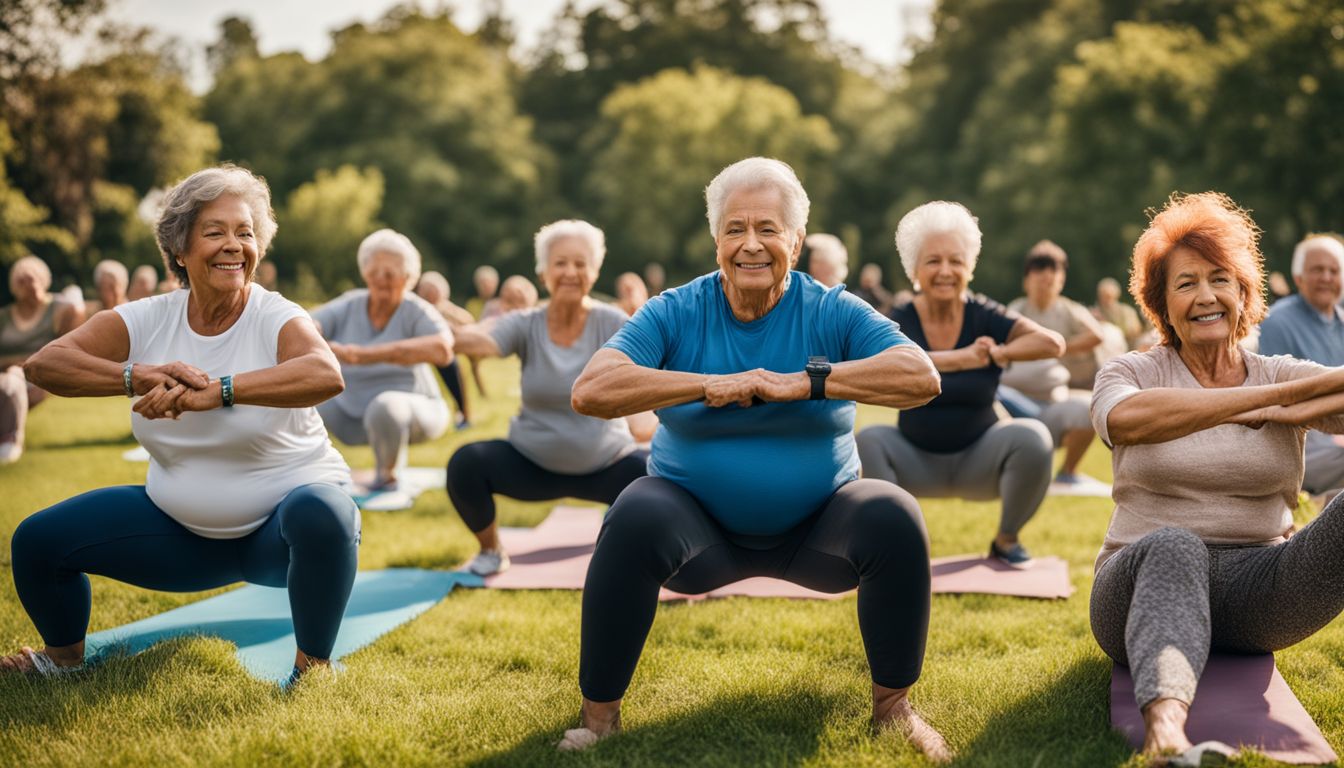Dealing with hip bursitis can be a real pain, literally, for many seniors out there. It’s all about the inflammation wreaking havoc in those small fluid-filled sacs around your hips.
But don’t worry, this post is packed with exercises tailored to ease that discomfort and get you moving freely again. Read on to give your hips the TLC they deserve!
Key Takeaways
- Hip bursitis exercises strengthen glutes and improve flexibility, making daily activities easier for seniors.
- Starting with gentle movements and focusing on the proper form helps avoid further injury or pain from hip bursitis.
- Alongside exercise, treatments like physical therapy, pain management, and possibly surgery contribute to pain relief for hip bursitis.
- Preventing future hip bursitis involves maintaining strong hips, stretching regularly, avoiding strenuous activities that hurt the hips, wearing supportive shoes, and managing weight.
- Listening to your body’s signals during exercise can guide seniors in safely managing their hip bursitis symptoms.
Understanding Hip Bursitis

Hip bursitis, a condition that brings a wince with every step—the result of inflammation where the bursa becomes the unwanted mediator between bone and soft tissue. Let’s delve into what sparks this fiery discomfort and unpack the signs to watch for as we peel back the layers on hip bursitis and its cozy relationship with aging joints.
Causes of Hip Bursitis
Repeated actions can make your hips angry. Think of it like using the same muscles over and over—eventually, they get tired and inflamed. This is what often leads to hip bursitis in older adults.
If you fall or bang your hip, that might kick off the pain, too.
Conditions like osteoarthritis or rheumatoid arthritis don’t help either; they can stir up trouble in your joints, making them swell. This swelling sometimes targets the bursae near your joints, causing a whole lot of discomfort at the sides of your hips.
Symptoms and Risk Factors
Hip bursitis hits hard, often catching older adults off guard. The pain can be sharp, making even simple moves tough.
- Intense pain is a tell-tale sign. It flares up at night and when you’re lying on the affected hip.
- The pain also gets worse after walking or standing for long periods.
- You might feel stiffness in your hip joint. Moving around becomes harder.
- Swelling and redness over the hip signal inflammation and can make your clothes feel snug.
- Risk factors include past injuries to the hip area. A fall or bump can kickstart bursitis.
- Age plays a big role. The older you get, the more likely you are to experience it.
- Certain jobs and activities increase risk, too. Think gardening or stair climbing that stresses the hips over time.
- Women face a higher chance of developing hip bursitis, especially as they grow older.
- Being overweight puts extra pressure on your joints, including the hips, which can trigger bursitis.
- Posture problems? They contribute to hip discomfort as well. Poor posture stresses your muscles and tendons.
- If you have bone conditions like scoliosis or arthritis, they add to your risk for bursitis in the hips.
The Importance of Exercise for Hip Bursitis

Keeping those hips in motion isn’t just about staying active—it’s a key strategy for seniors battling hip bursitis. Regular exercise goes beyond mere movement, becoming a powerful ally against the stiffness and discomfort this condition can bring, helping to restore function and maintain that precious independence.
Strengthening the Hip Muscles
Strong hips are key for keeping you moving and pain-free. Exercises that work your glutes make a big difference in treating hip bursitis. They help keep your hips steady and strong.
With moves like side-lying leg lifts, you target the outer parts of your glutes. These muscles support your hip’s side area well.
Chair squats and fire hydrant exercises give power to those important hip areas too; they’re great for seniors who want to stay active without strain. By building up strength here, you prepare yourself for smooth, stable movements in everyday life—and cut down on discomfort from hip bursitis.
Ready to boost mobility? Let’s look at how exercise can loosen up tight spots and make moving around easier.
Increasing Mobility
Once your hip muscles get stronger, it’s time to focus on making them move better. Mobility is all about how easily your joints can move through their full range of motion. More mobility in your hips means you can walk, climb stairs, and bend down without feeling tight or painful.
Exercises like leg lifts and stretches help loosen up tight areas around your hips. They allow you to move more freely and do daily tasks with less trouble. Remembering to keep moving each day will make a huge difference for your hip health! Say goodbye to stiffness as you welcome smoother steps into your routine.
Easing Pain
Exercise can be a great way to ease the pain from hip bursitis. Gentle movements help reduce stiffness and improve blood flow to the sore area. When you move, your body releases natural painkillers called endorphins.
These exercises are designed to target the muscles around your hips, making them stronger and more flexible.
It’s important not to overdo it, though. Start with low-impact activities that don’t put too much stress on your joints. Things like swimming or cycling might feel good since they allow you to move without hitting the ground hard.
If you’re in a lot of pain, ice therapy and over-the-counter medicines like Advil can provide quick relief. For those with persistent discomfort, physical therapy or even corticosteroid injections may be suggested by healthcare professionals.
Remember, regular gentle exercise is key for managing hip bursitis long-term!
Effective Hip Bursitis Exercises for Seniors

Navigating the journey toward relief from hip bursitis, seniors can find solace in a sequence of tailored exercises. These movements are designed not only to alleviate discomfort but also to fortify the hip area—enhancing both stability and flexibility while keeping you active and independent.
Glute Bridge
Lie on your back with your knees bent and feet flat on the floor. Your arms should rest by your sides, palms down. Push through your heels to lift your hips up towards the ceiling.
Squeeze those glutes tight as you rise! Hold it there for a few seconds, and then slowly lower back down.
This exercise is great because it works out your glute muscles, which are key to hip stability. It also helps protect those little cushioning sacs around your hips, called bursae, from too much rubbing and pressure.
When done regularly, glute bridges can mean less pain and better movement for everyday activities.
Side-lying Leg Lift
Side-lying leg lifts are a great way to strengthen the muscles around your hips. They focus on the outer glutes which support your hip’s stability. To do them, you’ll need to lie on one side with your legs stacked and straight.
Lift the top leg up while keeping it straight, then hold for a few seconds before bringing it back down slowly.
Aim for 15 to 20 lifts on each side for best results. These exercises can really help if you’re dealing with hip bursitis pain or just want stronger hips. Make sure you take breaks as needed and don’t push through sharp pain – staying safe is key!
Clamshell
The clamshell is a great move to work your hip abductors. It’s perfect for beginners and easy on the joints. Lie on your side with knees stacked and bent at a 45-degree angle. Keep feet together as you raise your upper knee, but keep the lower leg on the ground.
Imagine a clamshell opening as you do this movement. Your hips will thank you for it! Shoot for 2 to 3 sets of 10 lifts each.
After mastering the clamshell, try adding Chair Squat to your routine. This exercise builds strength in bigger muscle groups around the hips and thighs. Stand up straight, sit back slowly into a chair, then stand back up without using your hands if possible—it’ll boost your stability and power!
Chair Squat
Chair squats are great for your legs and hips. To do them, stand in front of a chair with your feet shoulder-width apart. Keep your chest lifted and back straight as you bend at the knees.
Pretend you’re about to sit down, but stop right before you touch the chair. Then, push through your heels to stand up straight again.
This exercise can help make your quads, hamstrings, and glutes stronger. It also keeps your hip joints moving smoothly. Remember to go slow and steady—no need to rush! Just lower yourself slowly towards the chair and then rise back up with control.
If it feels tough at first, that’s okay; stick with it, and you’ll get stronger over time!
Fire Hydrant
Get ready to strengthen those glute muscles with the fire hydrant exercise. Imagine like you’re a dog by a fire hydrant—yes, really! You’ll be on all fours, then lift one leg out to the side while keeping your knee bent.
It’s like opening and closing a gate with your leg. This move is great for stabilizing your legs and giving strength where it’s needed most.
Make sure you have a soft surface or pillow under your sore hip so it doesn’t hurt more. Stick with this exercise, and in just 1-2 weeks of doing them consistently, you might start feeling less pain on the outside of your hip.
Don’t forget—you can also ease that hip discomfort with a cold pack after exercising. Keep up the good work for better movement and less pain!
Side Plank
Side Planks are a powerful move for strengthening your glute muscles. They also help make your hips more stable. To do this exercise, lie on your side with legs straight. Prop yourself up with your forearm so that your body forms a diagonal line.
Rest your other hand on top of your hip and tighten your belly muscles to lift the pelvis off the floor. Hold this position as you breathe deeply.
Keep shoulders down away from ears and keep ankles stacked while doing Side Planks. This helps work core muscles along with those in the hips for better balance and stability. A strong core is vital, especially as we get older, because it supports our entire body, keeping us safe during daily activities.
Tips for Performing Hip Bursitis Exercises Safely

To protect your joints and ensure maximum benefit, it’s crucial to approach hip bursitis exercises with caution; keep reading for insider tips on how to exercise effectively without risking further injury.
Start Slowly
Jumping into new exercises can be tough on your body. Take it easy at first. Begin with gentle moves and a few repetitions that won’t hurt your hips or make the bursitis worse. As days go by, you can slowly add more repetitions to build strength and endurance without overdoing it.
As you exercise, paying attention to what your body says is key. If something hurts, take a break – there’s no need to push through pain. It’s important to get stronger and move better but do it in ways that keep you safe and comfortable.
Always check with a healthcare pro before starting these exercises, especially if hip bursitis bothers you.
Focus on Proper Form
Once you’re comfortable with a slower pace, proper form is your next step to safe exercising. Good form means moving your body the right way during each exercise. This helps protect your joints and muscles from strain or injury.
For example, if you’re doing a glute bridge, make sure your feet are flat on the floor and hip-width apart before lifting your hips.
Holding the correct posture while performing leg lifts or clamshells keeps pressure off of your hip bursa. It also ensures that the right muscles work hard during each movement. Ask a physical therapist to show you how it’s done—they can give personalized tips for getting it just right.
Keeping your movements smooth and controlled will help strengthen those gluteal muscles without causing extra pain or damage to the hip area.
Listen to Your Body
Paying attention to how your body feels is just as crucial as perfecting your form. If an exercise causes pain, don’t push through it; this could worsen your bursitis. Instead, take a break or try a gentler movement.
Your muscles may feel sore when you start new activities, but sharp or increasing pain is a sign to stop.
Sticking with exercises that make you comfortable ensures you’ll keep going without injury. As you build strength and flexibility in the hip area, listen for any signals of discomfort or fatigue.
This will help you adjust as needed and maintain a steady path toward healing your hips. Remember, gradual progress leads to lasting improvement in managing hip bursitis symptoms over time.
Additional Treatments for Hip Bursitis
While exercises are a key part of managing hip bursitis, sometimes you need more arrows in your quiver to effectively target the pain and discomfort. From hands-on techniques by physical therapists to innovative options like cryotherapy, there’s an array of additional treatments that can complement your exercise regimen, ensuring you get back to living life with less pain and more pep in your step.
Physical Therapy
Physical therapy can be a game-changer for seniors with hip bursitis. It’s not just about doing exercises; it’s a whole program designed to make hips stronger and more stable. Therapists work with you to lessen the rubbing on your bursae—the small, jelly-like sacs that cushion your bones.
This helps take away some of the pain and makes moving around easier.
In physical therapy sessions, you’ll focus on specific strengthening exercises. These are meant to wake up those glute muscles at the back of your hips—they’re like the bodyguards for your tendons and legs.
With these muscles in tip-top shape, they do a better job keeping everything else around them steady and strong.
Pain Management
Managing pain is key to dealing with hip bursitis. Over-the-counter pain meds like Aleve can ease your discomfort. Ice therapy helps, too; it reduces swelling and dulls the ache. If pain sticks around, a doctor might suggest corticosteroid injections.
These shots bring down inflammation right at the sore spot.
Sometimes, creams help when pills don’t do the trick. Voltaren gel is an anti-inflammatory you rub on your skin to calm pain in the area. For chronic cases that resist other treatments, surgery could be an option—but it’s usually a last resort.
Your doctor will guide you through choices based on what’s best for your health and comfort.
Surgery
Sometimes, even after exercise and other treatments, hip bursitis pain won’t go away. In these cases, doctors might suggest surgery. This procedure is called a bursectomy. The surgeon works to take out the swollen bursa to reduce your pain.
Most people have less pain after this surgery and can move better.
If you’re thinking about surgery, talk with your doctor about what it involves. They will help you understand the risks and benefits of the operation. Now, let’s look at preventing future hip bursitis pain so you can stay active and comfortable.
Preventing Future Hip Bursitis Pain
To stop hip bursitis pain from coming back, keep your hips strong and flexible. Use exercises like the chair squat to make your legs strong without putting too much stress on your hips.
Stretch daily to maintain good range of motion in your joints. This can help you move easier and prevent stiffness.
Avoid activities that hurt your hips or make them feel tired. If something makes your hip sore, take a break or try a different exercise that does not cause discomfort. Wearing proper shoes provides support and keeps you balanced, which is important for protecting your hips during walks or workouts.
Stay at a healthy weight to put less strain on all of your joints, including the hips. Remember to always warm up before exercising and cool down afterward; this can reduce the risks of injuring the muscles around the hip joint.
Conclusion
Exercising can be a game changer for seniors with hip bursitis. Strong glutes and flexible hips make everyday moves easier. Remember, it’s all about taking it slow, using proper form, and tuning into your body’s signals.
With the right exercises, you can ease pain and boost mobility. Keep moving, keep strengthening – your hips will thank you!
FAQs
1. What are the best exercises for seniors with hip bursitis?
Great question! For seniors dealing with hip bursitis, gentle movements like the clamshell exercise and bridge exercise can really help. These workouts target muscles around the hip to improve mobility without too much strain.
2. Can physical activity make hip bursitis worse?
It’s a common worry that exercise might hurt if you have hip bursitis, but it’s not true if done right! Low-impact cardio exercises, like using an elliptical machine or riding a stationary bike, keep joints moving and can ease pain in your hips.
3. Are there non-exercise treatments for trochanteric bursa inflammation?
Absolutely – besides exercises, things like cold compresses for pain relief and anti-inflammatory medications can tackle swelling in the trochanteric bursa. And don’t forget manual therapy from professionals—it all helps!
4. How does strengthening my gluteus muscles relieve hip pain?
Strengthening those glutes is key! When these muscles get stronger, they support your hips better and reduce the stress on your iliotibial band and tendons—that means less pain in your hips!
5. Is it okay to do weight-bearing exercises when I have hip bursitis?
Listen up: moderation is crucial here! Some weight-bearing exercises are great — just start slow to avoid overstretching or stressing out that sensitive area near your femur bone.
6. Will exercising prevent me from needing a hip replacement due to chronic inflammation?
Here’s the scoop—staying active keeps those lower-body muscles strong which supports your joints big time! So yes, regular exercise might lower the chance of needing something as major as a hip replacement by keeping all that synovial fluid moving smoothly around your joint.





